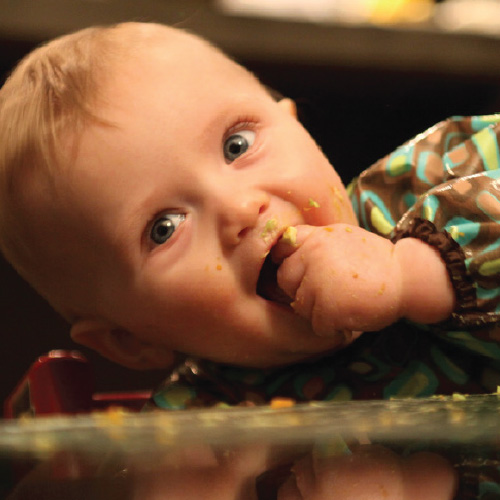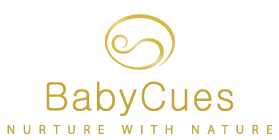Traditional, or Baby Lead Weaning?

Research shows us that a baby’s digestive system is developed enough at six months of age to receive solid food. However, one must ask the question, are our baby’s systems really ready to break down chunky foods at six months? And as Baby Led Weaning (BLW) suggests, can our baby’s truly choose if they are hungry, or full at that age? But before we answer these questions, let’s define these two forms of introducing solid food.
Main features of traditional weaning:
- Baby's fed pureed food at around 6 months old, offered soft lumps within this and soft finger foods around 7-8 months and more textured food is slowly added to this at around 8-12 months (1)
- Baby joins in with family meals
- Food is placed into baby’s mouth
- Baby may be enticed to eat
- Baby will be fed from a spoon the majority of time
Traditional weaning starts with parents offering their baby purees, or mashed food. This form of solid introduction has worked for generations and most parents and health professionals still work with this method. No research shows any ill effects of traditional weaning, and no questions of concern are outstanding with this approach especially if the pureed foods are homemade – unlike baby lead weaning.
Main features of baby led weaning:
- No puree’s or mashed food, only finger food or chunky food is offered
- Baby is not spoon fed
- Baby ‘chooses’ what to eat and how much
- Baby joins in with family meals
- Baby is not coaxed to eat at any point
When we look at the research around BLW we actually find that there is no substantial research too back up this form of solid introduction and, in my opinion, the reasons for offering BLW are also a little ambiguous – yes, while I truly believe in parenting choice, I am of the generation of traditional weaning and, after researching the reasons behind BLW, will personally remain advocating the traditional transition onto solids.
Why I advocate traditional weaning
- The World Health Organisation's guidelines recommend starting solids at six months because research indicates that the internal digestive system is mature enough then. But this recommendation is based on the traditional method of weaning, not BLW which has newborns exploring/swallowing whole foods rather than pureed.

- For six months your baby has only been processing liquid through their digestive tract and it took them a while, when first born until probably around two months, to be comfortable with that feeling while adjusting to the changes within your breastfeeding diet. To then offer whole foods and ask your baby’s digestive system to process chunks of foods is, in my opinion, too big a leap for their overall digestive health. Especially because they are still developing the appropriate increase of digestive enzymes within the pancreas (2) to help breakdown solid food.
- One of the reasons given for BLW is that baby chooses what to eat and chooses when they are full and the offering of choice is seen as a beneficial practice. However, do they really choose, can they choose? These two reasons I find ambiguous when we shine a spotlight on a six month old baby’s physical development. We know that around six months newborns LOVE to place things in their mouth. They increase their chewing skills (thus stimulating more saliva to breakdown solid food) while exploring the world via their innate hand-to-mouth reflex. When we combine this inbuilt urge of placing things into their mouth, the natural reflex of swallowing that comes with this, and the known science that it can take 15-20 minutes after food is first eaten for the ‘full’ range of satiety signals to reach the brain (3), then the question is again, can they really choose when they are full, or are they actually being driven by their innate hand-to-mouth reflex, therefore, running the risk of overloading their system? At six months a newborns stomach can hold around 120mls and science tells us that for babies, the pace in which food is passed through the system is directly driven by the amount given. Therefore, if a baby cannot recognise they are full until 15-20 minutes after eating, and their hand-to-mouth exploration has them eating more food than their stomach can hold, the duodenum, intestines and bowel would probably have to cope with abnormal processes causing discomfort, unsettled behaviours and sleep, constipation, bloating, stomach and intestinal pain etc.
- Your baby’s first molars (chewing teeth) will usually come through between 12-18 months of age – perhaps nature is trying to tell us something here? One paper I found contradicted the ‘whole food’ suggestions of BLW stating that, ‘most infants at six months do not possess the oral function to break up soft food in their mouth and move it around in order to swallow it. (4)
- Currently no large well-designed study has investigated the risk of failure to thrive in infants following BLW, although one small study suggests that it may be an issue for some infants. (5) It is uncertain whether an infant’s physical stamina could impact on their self-feeding ability, or energy intake. At greatest risk of failure to thrive would be infants whose self-feeding skills are less than optimal and who are left to their own devices, receiving no assistance from their parents, which is in encouraged in BLW. (4)
- The lack of dietary intake or growth information means it is not known whether BLW infants are meeting their energy requirements. It is feasible that lack of awareness of suitable BLW foods means some infants will be offered predominantly fruit and vegetables as the basis of their BLW diet which may provide insufficient energy for their needs. (4) If you do choose to do BLW then it is important to introduce food that is high in iron as a six month old's need this for this rises at this age. It is also important to be aware of how much sugar and salt is being fed, given that BLW advises feeding the same food as the family is eating.
- Currently the Ministry of Health does not recommend BLW for New Zealand babies because of the lack of research.
To summarise
I believe it is important for parents to gather all the information they can about the natural biology of their newborn and differentiate between the facts of this and social assumptions e.g. that newborns have the ability to override their instinctive ‘hand-to-mouth’ development, make a choice, and know when they are full. I liken this to a four year old going to the cupboard for another chocolate biscuit again and again. They will keep eating them if we let them, it’s up to us to know what is healthy for their age and natural digestive capabilities and guide them when ‘enough is enough.'

While there is very little research to back up BLW I know from my own experience that the lack of official research doesn’t necessarily mean something doesn’t work, so when I started this article I did so with an open mind. However the fact remains that positive outcomes occur time and time again in my practice when I return six to nine month old babies to a very basic, pureed or soft food diet. Marry this with the information I have discovered about BLW and I find myself reiterating again, ‘let’s place our feet into theirs a little more.’ What’s the rush? It’s not like they are never going to eat chunky foods if you don’t give them at six months, so why not introduce solids in a way that gently teaches their digestive system how to process solid food? And why not introduce them to a spoon and the exploration of using their hands – where is the harm in doing both? I sometimes think we have gone too far in defining ‘choices’ for parents – it’s either this way, or that, no in-between.
So, what are my recommendations for introducing solids
- Introduce pureed food, ideally homemade, at six months of age until around eight months. You may like to read this blog about commercial baby rice)
- Soft textured food to be offered at around eight to nine months
- More textured, chunky food from nine to twelve months.
For those of you that would like to explore BLW more, there are some helpful links within the references below and you may also like to research Gill Rapley, the lady that coined BLW.
References:
- New Zealand Ministry of Health, ‘Eating for Healthy Babies and Toddlers’
- The pancreas is involved in sugar control and metabolism within the body, and also in the secretion of substances which help digestion. The pancreas plays a vital role in the digestive system. It secretes fluid that contains enzymes into the duodenum. These enzymes help to break down carbohydrates, usuallystarch, proteins and lipids (fats). This role is called the "exocrine" role of the pancreas.
- British Nutrition Foundation
- Cameron S., Heath M., Taylor R. How feasible is Baby-Led Weaning as an Approach to Infant Feeding? A review of the Evidence http://www.ncbi.nlm.nih.gov/pmc/articles/PMC3509508/
- Townsend E., Pitchford N. Baby knows best? The impact of weaning style on food preferences and body mass index in early childhood in a case-controlled sample. BMJ Open. 2012;2:e000298. doi: 10.1136/bmjopen-2011-000298. [PubMed] [Cross Ref]


